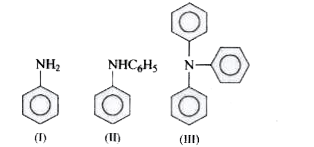Arrange the following in the order of their increasing size : Cl−,S2−,Ca2+,Ar
To arrange the ions Cl^(-), S^(2-), Ca^(2+), and Ar in order of their increasing size, we will follow these steps:
Step 1: Identify the number of electrons
- Cl^(-) has 17 protons and gains 1 electron, giving it a total of 18 electrons.
- S^(2-) has 16 protons and gains 2 electrons, giving it a total of 18 electrons.
- Ca^(2+) has 20 protons and loses 2 electrons, giving it a total of 18 electrons.
- Ar has 18 protons and has 18 electrons.
Step 2: Determine if they are isoelectronic
All four species (Cl^(-), S^(2-), Ca^(2+), and Ar) have the same number of electrons (18). Therefore, they are isoelectronic.
Step 3: Understand the effect of charge on size
In isoelectronic species, the size of the ions is influenced by the nuclear charge (the number of protons):
- A higher positive charge (more protons) pulls the electrons closer, resulting in a smaller ionic size.
- A higher negative charge (more electrons) results in a larger ionic size.
Step 4: Compare the ions based on their charges
- S^(2-) has the most negative charge (2-), which means it will be the largest.
- Cl^(-) has a negative charge (1-), so it will be smaller than S^(2-).
- Ar is neutral (0 charge), so it will be smaller than both S^(2-) and Cl^(-).
- Ca^(2+) has a positive charge (2+), which means it will be the smallest among these ions.
Step 5: Arrange in increasing order of size
Based on the analysis:
1. Ca^(2+) (smallest)
2. Ar
3. Cl^(-)
4. S^(2-) (largest)
Final Order
The order of increasing size is:
Ca^(2+) < Ar < Cl^(-) < S^(2-)
---
- Cl^(-) has 17 protons and gains 1 electron, giving it a total of 18 electrons.
- S^(2-) has 16 protons and gains 2 electrons, giving it a total of 18 electrons.
- Ca^(2+) has 20 protons and loses 2 electrons, giving it a total of 18 electrons.
- Ar has 18 protons and has 18 electrons.
All four species (Cl^(-), S^(2-), Ca^(2+), and Ar) have the same number of electrons (18). Therefore, they are isoelectronic.
In isoelectronic species, the size of the ions is influenced by the nuclear charge (the number of protons):
- A higher positive charge (more protons) pulls the electrons closer, resulting in a smaller ionic size.
- A higher negative charge (more electrons) results in a larger ionic size.
- S^(2-) has the most negative charge (2-), which means it will be the largest.
- Cl^(-) has a negative charge (1-), so it will be smaller than S^(2-).
- Ar is neutral (0 charge), so it will be smaller than both S^(2-) and Cl^(-).
- Ca^(2+) has a positive charge (2+), which means it will be the smallest among these ions.
Based on the analysis:
1. Ca^(2+) (smallest)
2. Ar
3. Cl^(-)
4. S^(2-) (largest)
The order of increasing size is:
Ca^(2+) < Ar < Cl^(-) < S^(2-)
Topper's Solved these Questions
- CLASSIFICATION OF ELEMENTS AND PERIODICITY IN PROPERTIES BOOK - VMC MODULES ENGLISHCHAPTER - CLASSIFICATION OF ELEMENTS AND PERIODICITY IN PROPERTIES EXERCISE - JEE MAIN (ARCHIVE)
13 Videos
- CHEMICAL THERMODYNAMICS BOOK - VMC MODULES ENGLISHCHAPTER - CHEMICAL THERMODYNAMICS EXERCISE - IN - CHAPTER EXERCISE - L
10 Videos
- ELECTROCHEMISTRYBOOK - VMC MODULES ENGLISHCHAPTER - ELECTROCHEMISTRYEXERCISE - IMPECCABLE
50 Videos
Similar Questions
Knowledge Check
Arrange the following in increasing order of basicity :
 AS<Q<R<PBS<Q<P<RCS<R<P<QDP<Q<R<S
AS<Q<R<PBS<Q<P<RCS<R<P<QDP<Q<R<SArrange the following in increasing order of basicity.
 AI<II<IIIBIII<I<IICIII<II<IDII<III<I
AI<II<IIIBIII<I<IICIII<II<IDII<III<IArrange the following in increasing order of stability.
 AI<II<IIIBII<I<IIICI<III<IIDII<III<I
AI<II<IIIBII<I<IIICI<III<IIDII<III<I
Arrange the following ions in order of their increasing size: Li+,Mg2+,K+,AI3+.
View SolutionArrange the following in descending order of their size.
View SolutionArrange the following in the increasing order of their acidity.

View SolutionArrange the following ions in the increasing order of their size: Be2+,CI−,S2−,Na+,Mg2+,Br−1?
View SolutionArrange the following ions in the increasing order of their size: Be2+,CI−,S2−,Na+,Mg2+,Br−1?
View Solution
